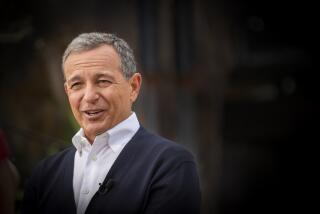Column: The first official report on CEO-worker pay ratios shows an enormous 333-1 gap at Honeywell
The first government-mandated disclosure of the ratio of CEO vs. average worker pay has surfaced, and as has been widely expected, it’s obscene. Technology company Honeywell, in a proxy statement dated Friday, disclosed that its CEO, Darius Adamczyk, was paid 333 times as much as a median Honeywell employee last year.
The raw figures are these: Adamczyk, $16.8 million. Median employee: $50,296.
Honeywell is the first major public corporation to make the disclosure, which was required by the Dodd-Frank financial reform act and is subject to rules implemented by the Securities and Exchange Commission starting this year. Its 333-to-1 ratio is in the neighborhood of what informal surveys have been projecting for public corporations in general.
This is a confirmation of research done up to now.
— Sam Pizzigati, Institute for Policy Studies
The labor-oriented Economic Policy Institute, for example, estimated that CEOs were making as much as 270 times that of their average workers in 2016. The Institute for Policy Studies, which tracks indicators of income and wealth inequality, estimates the 2016 ratio at 347-to-1.
“This is a confirmation of research done up to now,” Sam Pizzigati, a fellow at IPS, says of the Honeywell data. He expects some corporations to show much larger discrepancies. That could show up especially in the retail sector, where median earnings are likely to be well below the $50,000 level of Honeywell’s heavily professional workforce.
Walmart, for instance, says its average hourly pay for full-time workers was to reach $13.38, following a company-wide wage increase in 2016. That’s about $27,800. Its CEO, C. Douglas McMillon, was paid $22.4 million last year. That would create a ratio of about 805-to-1 based on hourly wages alone.
The pay ratio is important because it’s a powerful indicator of economic inequality. While average worker wages have been stagnant for decades, the top 1% of U.S. income earners have “more than doubled their share of the nation’s income” since the 1970s, the IPS observes. Corporate executives head about two-thirds of America’s households in the top 1%, the think tank adds.
Moreover, the ratio has been expanding rapidly. In 1980, the ratio was about 42-to-1. Even that was way out of line with the 20-to-1 that the great management guru, Peter Drucker, thought was appropriate. That’s “the limit beyond which they cannot go if they don’t want resentment and falling morale to hit their companies,” Drucker wrote, according to a comment on the CEO pay rule submitted to the SEC by the Drucker Institute at Claremont Graduate University.
As I reported in 2013, when the SEC was taking comments on the Dodd-Frank mandate, Drucker’s standard seems positively quaint today. By 2012, the average CEO-to-worker pay ratio had reached about 350-to-1. The only thing that had held it back was the 2008 recession.
Public corporations fought fiercely against the SEC disclosure rule. It was obvious why: The disclosures are going to be telling, and massively embarrassing.
Keep up to date with Michael Hiltzik. Follow @hiltzikm on Twitter, see his Facebook page, or email [email protected].
Return to Michael Hiltzik’s blog.
More to Read
Inside the business of entertainment
The Wide Shot brings you news, analysis and insights on everything from streaming wars to production — and what it all means for the future.
You may occasionally receive promotional content from the Los Angeles Times.











